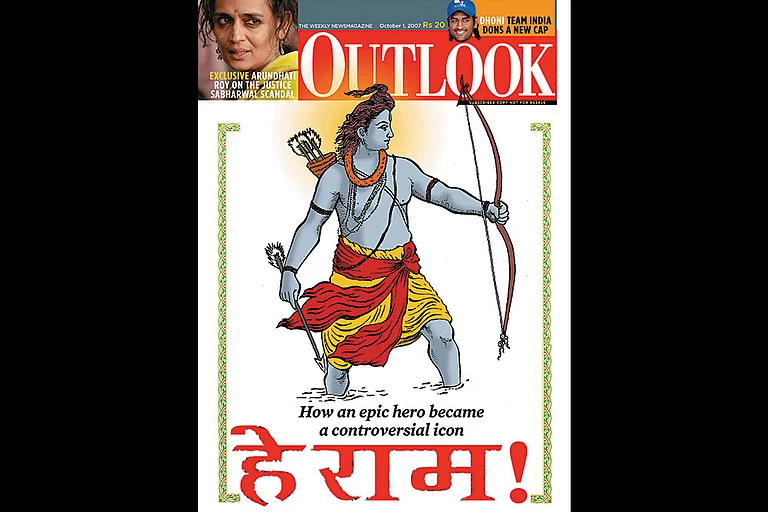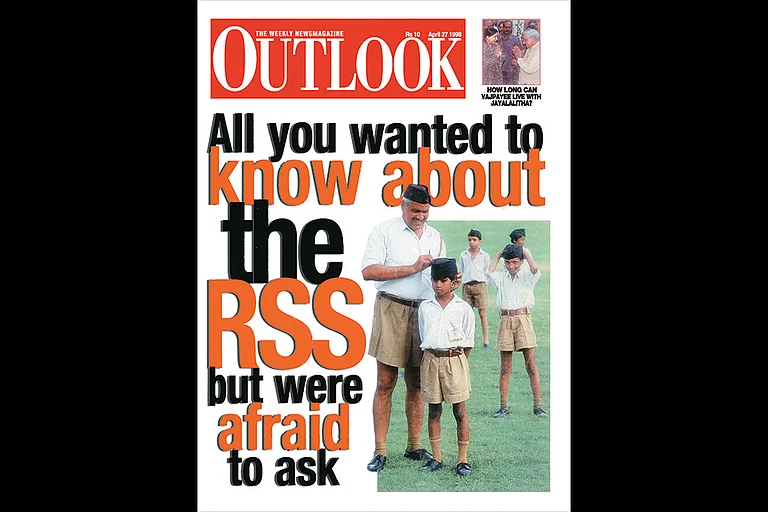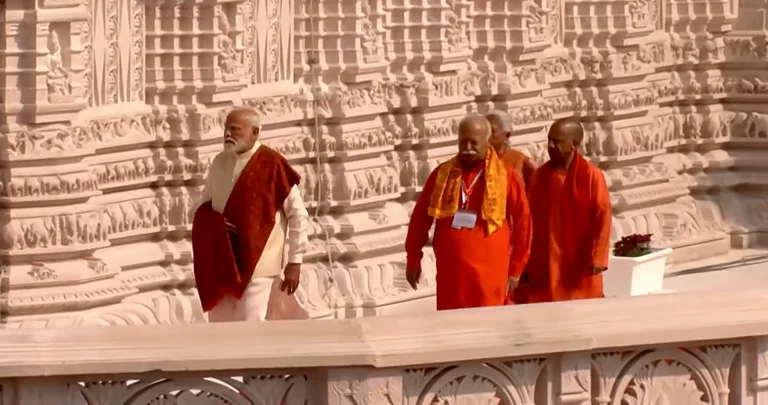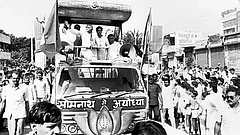The name Uddharak Baba is not as popular in Ayodhya as it used to be a few decades ago. Many of the younger residents and the new migrants settling in the ancient town have no idea about who Uddharak Baba aka Abhiram Das aka Abhinandan Mishra is, or why his photo, alongside other saints, is on billboards of ‘new’ Ayodhya ahead of the consecration of the Ram Temple.
But Abhiram Das’ septuagenarian disciple, Dharam Das, who lives in a decrepit ancient Hanumangarhi bylane, elicits a knowing smile. “They are trying to mollycoddle the saints with publicity,” the mahant (chief priest) of Nirvani Akhada states.
Beside his dishevelled cot in a musty room is an image of Abhiram Das, the man who placed an idol of Ram Lalla inside the Babri Masjid for the first time in 1949. “He was the first to put Ram back in his home and convert the mosque into a temple. Not just him, several other saints have contributed to the success of the Ram Janmabhoomi movement and risked their lives for this cause. Now, it’s more about show and pomp,” Das states, adding, “Ayodhya is changing”.
Ahead of the consecration of the Ram temple, Dharam Das, who was one of the litigants in the Ram Janmabhoomi-Babri Masjid title dispute and had even supported the idea of giving away land belonging to Ram Janmabhoomi Nyas in Ayodhya to the Muslims for building a mosque (given that they gave up their claim on the disputed land), appears reticent and speaks in metaphors.
Political journalist Dhirendra K Jha, who has been covering the developments in Ayodhya as well as right-wing politics in northern India for decades, feels that though the history of Ayodhya and worship of Ram itself dates back several thousand years in the region, the contemporary Ram Janmbhoomi politics that began in the 20th century can be broadly categorised into three periods: 1949, 1980s and post-2014.
The first movement started with the surreptitious planting of idols in Babri Masjid on December 22, 1949, led by Baba Abhiram Das, who had links with the Hindu Mahasabha, which in 1949 first unveiled the “Ayodhya Kashi Mathura” strategy.
“All the important players in this movement belonged to the Hindu Mahasabha. They were supported by the local administration. They were supported indirectly, even by then Uttar Pradesh Chief Minister GB Pant, because he didn’t take the action that he should have taken in the aftermath of the illegal planting of the idol,” Jha states.
While the momentum weakened eventually at the national stage after 1950, back in the by-lanes of Ayodhya, Dharam Das remembers that the movement among the sadhu samaj persisted along with annual celebrations of Ram Prakat Utsav to commemorate the auspicious moment when the statue of Ram Lalla miraculously appeared inside the mosque.
By the late 1970s, the intensity of the celebrations fizzled out, but the tales of the miracle survived and helped fuel a Hindu revivalist movement that returned with extreme political fervour in the 80s.
On January 4, 1984, hundreds of kar sevaks responded to a call by the Vishwa Hindu Parishad (VHP), which was formed in 1964 to consolidate ‘Hindu society’ and climbed on the central dome of Babri, where they hoisted the Hanuman flag. In subsequent years, the VHP played key roles in the 1989 shilanyas of the Ram Mandir conducted by the Rajiv Gandhi government, the 1990 rath yatra led by LK Advani and the eventual demolition of the mosque in 1992.

Priests and Kings
In Gorakhpur, 250 kilometres from the Ram Mandir, the marble spires of the Gorakhnath Dham glimmer with new flags in celebration of Khichdi Parv. Inside, the elderly priest Dwarikanath Tiwari is pacing the corridors tensely, waiting for news of the arrival of Chief Minister, Yogi Adityanath, the chief priest of the Gorakhnath Math, visiting his hometown ahead of the Ram Mandir inauguration to ensure all was smooth. Inside a cavernous hall within the temple premises are megalithic statues of former mahants, including Yogi’s predecessors—Avaidyanath and Digvijyanath before him.
“If it wasn’t for them, the Ram Mandir movement would be nowhere,” Dwarikanath states. When asked who gets credit for the temple, Dwarikanath, who has been a close aide of Yogi as well as Avaidyanath, looks irate. “It’s Yogi ji and Modi ji. Who else?”
It was Digvijaynath, who in the 1940s, became the first priest of the ancient Math to join politics and was key in developing the “Ayodhya strategy” along with KK Nayyar and VD Savarkar. Later, in 1984, Adityanath’s predecessor and mentor, Mahant Avaidyanath, formed the Sri Ram Janambhumi Mukti Yagna Samiti (Committee of Sacrifice to Liberate Ram’s Birth Place), which gave a jumpstart to the movement and brought it under the active fold of politics. Much like Digvijaynath, Avaidyanath was a man of God and also a hardened politician. Formerly a member of the Hindu Mahasabha, Avaidyanath later joined the BJP and had been a four-time MP from Gorakhpur.
“Many People Are Going To Be Visiting The Ram Temple In The Run-Up To The Elections. The Spectacle Will Definitely Be A Part Of Their Conscious Or Unconscious Memories When They Go To Vote In The Coming Months”.
The Ram Janmabhoomi movement has always had political actors. While the BJP has reaped the long-term benefits of the communal politics of the 80s and early 90s, veteran socialist leader and former Samajwadi Party MLA from Ayodhya, Jaiprakash Pandey, recalls that Congress leaders like Dau Dayal Khanna and others like Ashok Singhal played key roles in “disturbing the secular fabric” at the time.
With the crucial Lok Sabha elections slated to be held this year, the unveiling of the Ram temple takes on even greater significance. The hurried inauguration of the temple and the consecration ceremony in a temple that is as yet incomplete has led many, including opposition parties and some religious leaders, to criticise the party’s motives. “If BJP had Ram in their heart, they could have inaugurated the temple on Ram Navami in April, when it’s Ram Lalla’s birthday. But they chose this date simply because they want to create a spectacle before elections,” Pandey states.
Vote for Ram
Inside the century-old headquarters of the Geeta Press in Gorakhpur, BC Rai flips through pages of the special book that they have been printing to send to Ayodhya for the consecration ceremony. The slim book contains the history of Ayodhya and coloured prints of scenes from the Ramayana—a specialty of the Geeta Press, which has since 1923 been devoted to the publication of Hindu mythological and theological texts.

“It will be part of the prasad that devotees get,” Rai, the Press’s manager, states. Starting with the Bhagwad Geeta, the press brought out its first edition of the Ramayana in 1926. “Holy books were written in Sanskrit and there was a time when only pandits were able to read them. But the Geeta Press democratised the word of God among Indian masses in the formative years of the nation,” Rai states. The Press is expecting a massive increase in sales of Ramayana and Ayodhya-related books in the coming months.
Such imagery, according to political analyst Praveen Rai of CSDS, alongside the quite literal saffronisation of Ayodhya, helps create lasting impressions on the minds of devotees, who in just a few days’ time are set to vote to elect their new government.
“Many people are going to be visiting the Ram temple in the run-up to the elections and the spectacle there will definitely be part of their conscious or unconscious memories when they go to vote in the coming months,” Rai says. These tourists will return to their homes across the country and act as brand ambassadors for PM Modi, whose face is plastered on every wall, door and shop-front alongside that of Ram.
The analyst adds that the Congress and INDIA bloc’s refusal to attend the consecration also gives the ruling party an advantage. “It gives them a peg to criticise the opposition as “anti-Hindu or pro-Muslim. As of now, I can predict a two-three per cent swing in votes in favour of BJP, thanks to the temple,” he states. Rai adds that women and locals of Ayodhya are also in focus. “The party is sure to focus on women-centric schemes and the development of Ayodhya as an economic centre to appeal to voters,” Rai feels.
In the old, slim-brick homes of Ayodhya that lie behind the new facade, voices of discord clamour over the city’s faith. They belong to people like Preeti Jasiwal, who demands clean water at her home and bathroom or Sushma Sahu, whose tears are not enough to stop the bulldozers from razing down part of her home, just days before the inauguration.
“They are saying Modi’s guarantee will benefit women and the poor, but we have not benefited from any of their schemes in the last 10 years, even though we have voted for him twice,” Jasiwal states.
MORE FROM THIS ISSUE
Rakhi Bose in Ayodhya
(This appeared in the print as 'A Paper City')
































